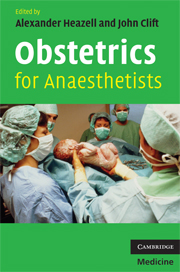Book contents
- Frontmatter
- Contents
- List of contributors
- Foreword
- Preface
- Acknowledgements
- List of abbreviations
- 1 Maternal physiology and obstetrics
- 2 Antenatal care
- 3 Induction of labour
- 4 Normal labour
- 5 Abnormal labour
- 6 Fetal monitoring
- 7 Pre-eclampsia and hypertensive disorders of pregnancy
- 8 Operative obstetrics
- 9 Obstetric haemorrhage
- 10 Thromboembolic disorders of pregnancy
- 11 Infection
- 12 Life support in obstetrics
- 13 Drugs in obstetrics
- 14 Confidential enquiries into fetal, neonatal and maternal death
- Appendix 1 Adult Advanced Life Support Algorithm
- Appendix 2 The Management of Postpartum Haemorrhage Algorithm
- Appendix 3 Emergency Management of Eclamptic Fit Algorithm
- Index
Foreword
Published online by Cambridge University Press: 21 August 2009
- Frontmatter
- Contents
- List of contributors
- Foreword
- Preface
- Acknowledgements
- List of abbreviations
- 1 Maternal physiology and obstetrics
- 2 Antenatal care
- 3 Induction of labour
- 4 Normal labour
- 5 Abnormal labour
- 6 Fetal monitoring
- 7 Pre-eclampsia and hypertensive disorders of pregnancy
- 8 Operative obstetrics
- 9 Obstetric haemorrhage
- 10 Thromboembolic disorders of pregnancy
- 11 Infection
- 12 Life support in obstetrics
- 13 Drugs in obstetrics
- 14 Confidential enquiries into fetal, neonatal and maternal death
- Appendix 1 Adult Advanced Life Support Algorithm
- Appendix 2 The Management of Postpartum Haemorrhage Algorithm
- Appendix 3 Emergency Management of Eclamptic Fit Algorithm
- Index
Summary
Obstetric anaesthesia is a specialty interest within anaesthesia that has many features different from other areas of practice. Most obviously two patients, mother and baby, are affected by the same anaesthetic. Most of the mothers are healthy and are expecting a healthy baby as the end result of a straightforward physiological process. It is a very emotional time and is distressing when complications occur, especially if these are life-threatening to mother or baby. Most women remain awake through childbirth whether they have a vaginal or Caesarean delivery and often look to the anaesthetist for reassurance. The anaesthetist who is aware of the ‘bigger picture’ and knows about the complications that might occur and how the obstetrician and midwife will deal with them will be able to provide this reassurance with confidence.
The role of anaesthetists in obstetrics has changed over the years, such that it is now unthinkable that they were once regarded as mere technicians to deliver anaesthesia for an emergency Caesarean section and then leave the obstetric unit to fulfil duties elsewhere. Epidural analgesia during labour has become an expectation of many mothers and it is now used by almost one quarter of women. The obstetric anaesthetist is now an integral part of the maternity team where they need to be effective.
The importance of effective interdisciplinary working for maternity care is emphasised in all documents relating to standards and planning of maternity services. These include successive Confidential Enquiries into Maternal Deaths, Safer Childbirth and Maternity Matters.
- Type
- Chapter
- Information
- Obstetrics for Anaesthetists , pp. xi - xiiPublisher: Cambridge University PressPrint publication year: 2008



